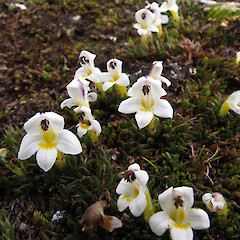Euphrasia integrifolia
Synonyms
None
Family
Orobanchaceae
Flora category
Vascular – Native
Endemic taxon
Yes
Endemic genus
No
Endemic family
No
Structural class
Herbs - Dicotyledons other than Composites
NVS code
The National Vegetation Survey (NVS) Databank is a physical archive and electronic databank containing records of over 94,000 vegetation survey plots - including data from over 19,000 permanent plots. NVS maintains a standard set of species code abbreviations that correspond to standard scientific plant names from the Ngä Tipu o Aotearoa - New Zealand Plants database.
EUPINT
Current conservation status
The conservation status of all known New Zealand vascular plant taxa at the rank of species and below were reassessed in 2017 using the New Zealand Threat Classification System (NZTCS) – more information about this can be found on the NZTCS website. This report includes a statistical summary and brief notes on changes since 2012 and replaces all previous NZTCS lists for vascular plants.
Please note, threat classifications are often suggested by authors when publications fall between NZTCS assessment periods – an interim threat classification status has not been assessed by the NZTCS panel.
- Conservation status of New Zealand indigenous vascular plants, 2017 . 2018. Peter J. de Lange, Jeremy R. Rolfe, John W. Barkla, Shannel P. Courtney, Paul D. Champion, Leon R. Perrie, Sarah M. Beadel, Kerry A. Ford, Ilse Breitwieser, Ines Schönberger, Rowan Hindmarsh-Walls, Peter B. Heenan and Kate Ladley. Department of Conservation. Source: NZTCS and licensed by DOC for reuse under the Creative Commons Attribution 4.0 International licence.
2017 | At Risk – Naturally Uncommon | Qualifiers: DP, RR, Sp
Previous conservation statuses
2012 | At Risk – Naturally Uncommon | Qualifiers: Sp
2009 | At Risk – Naturally Uncommon
2004 | Data Deficient
Distribution
Endemic to the South Island where it is though to occur only in Fiordland. It has been collected from the following ranges in Fiordland: Wilmot Pass, Mt Cleughearn (Type Locality), Lake Hauroko and the Princess Range. It has been recorded (but not collected) as far east as the Takitimu, Thomsom, Garvie and Umbrella Mountains in Southland and the Old Man Range in Otago.
Habitat
Damp alpine meadows and bogs.
Detailed description
Diminutive, prostrate, hairless, succulent herb, forming diffuse matted patches. Branches rooting at nodes, ascending at tips. Leaves succulent, without stalks, 3-4 mm long, obovoid-acuminate, leaf tip acute. Flowers few, near branch tips, very shortly stalked or on stalks the length of the leaves. Calyx 3-5 mm long, divided for half the length, lobes triangular, sharp tipped, succulent. Corolla white, 8-13 mm long, tube up to 10 mm long, much > calyx. Corolla lobes of lower lip up to 2 mm wide, entire. Anthers brown, with hairy margins.
Similar taxa
Closest perhaps to E. disperma but differing by the branches which root abundantly as they creep, and by the shorter floral tube.
Flowering
No information available
Flower colours
White
Fruiting
No information available
Life cycle
Seeds is dispersed by wind and possibly water and ballistic projection (Thorsen et al., 2009).
Propagation technique
A hemiparasite, and so impossible to cultivate without first undertaking a careful study of its host relationships.
Threats
Ashwin (in Allan 1961) states very little of this distinct species has been collected. This is probably still the case though P.J. Garnock-Jones (pers. comm.) stated it was common in some parts of Fiordland he had recently (2001) visited. Although it would seem unlikely to be seriously threatened the exact status of this species, perhaps because it is so small and easily over-looked is still uncertain.
Etymology
euphrasia: Eye-medicine
Attribution
Prepared by Bill Barker with reference to Allan (1961) and Phil Garnock-Jones (pers.comms)
References and further reading
Allan, H.H. 1961: Flora of New Zealand. Vol. I, Wellington, Government Printer.
Thorsen, M. J.; Dickinson, K. J. M.; Seddon, P. J. 2009. Seed dispersal systems in the New Zealand flora. Perspectives in Plant Ecology, Evolution and Systematics 11: 285-309






